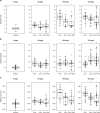Growth phase-specific evolutionary benefits of natural transformation in Acinetobacter baylyi
- PMID: 25848876
- PMCID: PMC4579475
- DOI: 10.1038/ismej.2015.35
Growth phase-specific evolutionary benefits of natural transformation in Acinetobacter baylyi
Abstract
Natural transformation in bacteria facilitates the uptake and genomic integration of exogenous DNA. This allows horizontal exchange of adaptive traits not easily achieved by point mutations, and has a major role in the acquisition of adaptive traits exemplified by antibiotic resistance determinants and vaccination escape. Mechanisms of DNA uptake and genomic integration are well described for several naturally transformable bacterial species; however, the selective forces responsible for its evolution and maintenance are still controversial. In this study we evolved transformation-proficient and -deficient Acinetobacter baylyi for 175 days in serial transfer cultures where stress was included. We found that natural transformation-proficient populations adapted better to active growth and early stationary phase. This advantage was offset by the reduced performance in the late stationary/death phase. We demonstrate fitness trade-offs between adaptation to active growth and survival in stationary/death phase caused by antagonistic pleiotropy. The presented data suggest that the widely held assumption that recombination speeds up adaptation by rapid accumulation of multiple adaptive mutations in the same genetic background is not sufficient to fully account for the maintenance of natural transformation in bacteria.
Figures





Similar articles
-
Costs and benefits of natural transformation in Acinetobacter baylyi.BMC Microbiol. 2017 Feb 15;17(1):34. doi: 10.1186/s12866-017-0953-2. BMC Microbiol. 2017. PMID: 28202049 Free PMC article.
-
No effect of natural transformation on the evolution of resistance to bacteriophages in the Acinetobacter baylyi model system.Sci Rep. 2016 Nov 21;6:37144. doi: 10.1038/srep37144. Sci Rep. 2016. PMID: 27869203 Free PMC article.
-
Rapid evolution of diminished transformability in Acinetobacter baylyi.J Bacteriol. 2006 Dec;188(24):8534-42. doi: 10.1128/JB.00846-06. Epub 2006 Oct 6. J Bacteriol. 2006. PMID: 17028281 Free PMC article.
-
Opportunities for genetic investigation afforded by Acinetobacter baylyi, a nutritionally versatile bacterial species that is highly competent for natural transformation.Annu Rev Microbiol. 2005;59:519-51. doi: 10.1146/annurev.micro.59.051905.105823. Annu Rev Microbiol. 2005. PMID: 16153178 Review.
-
Acinetobacter baylyi ADP1: transforming the choice of model organism.IUBMB Life. 2011 Dec;63(12):1075-80. doi: 10.1002/iub.530. Epub 2011 Oct 27. IUBMB Life. 2011. PMID: 22034222 Review.
Cited by
-
Serum Albumin and Ca2+ Are Natural Competence Inducers in the Human Pathogen Acinetobacter baumannii.Antimicrob Agents Chemother. 2016 Jul 22;60(8):4920-9. doi: 10.1128/AAC.00529-16. Print 2016 Aug. Antimicrob Agents Chemother. 2016. PMID: 27270286 Free PMC article.
-
New Provisional Function of OmpA from Acinetobacter sp. Strain SA01 Based on Environmental Challenges.mSystems. 2021 Jan 12;6(1):e01175-20. doi: 10.1128/mSystems.01175-20. mSystems. 2021. PMID: 33436517 Free PMC article.
-
Costs and benefits of natural transformation in Acinetobacter baylyi.BMC Microbiol. 2017 Feb 15;17(1):34. doi: 10.1186/s12866-017-0953-2. BMC Microbiol. 2017. PMID: 28202049 Free PMC article.
-
Using Sex to Cure the Genome.PLoS Biol. 2016 Mar 17;14(3):e1002417. doi: 10.1371/journal.pbio.1002417. eCollection 2016 Mar. PLoS Biol. 2016. PMID: 26987049 Free PMC article.
-
Effect of chemotherapeutic agents on natural transformation frequency in Acinetobacter baylyi.Access Microbiol. 2024 Jul 10;6(7):000733.v4. doi: 10.1099/acmi.0.000733.v4. eCollection 2024. Access Microbiol. 2024. PMID: 39135654 Free PMC article.
References
-
- Averhoff B, Graf I. (2008). The Natural Transformation System of Acinetobacter baylyi ADP1: A Unique DNA Transport Machinery. In: Gerischer U (ed). Acinetobacter—Molecular Biology. Caister Academic Press: Norfolk, UK, pp 119–139.
-
- Baltrus D. (2013). Exploring the costs of horizontal gene transfer. Trends Ecol Evol 28: 489–495. - PubMed
-
- Baltrus D, Guillemin K, Phillips P. (2007). Natural transformation increases the rate of adaptation in the human pathogen Helicobacter pylori. Evolution 62: 10. - PubMed
Publication types
MeSH terms
Substances
LinkOut - more resources
Full Text Sources
Other Literature Sources

